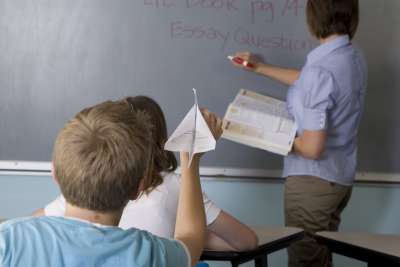Classrooms that successfully include students with disabilities are designed to welcome diversity and to address the individual needs of all students, whether they have disabilities or not. The composite scenario below is based on reports from several teachers. It provides a brief description of how regular and special education teachers work together to address the individual needs of all of their students.
Jane Smith teaches third grade at Lincoln Elementary School. Three days a week, she co-teaches the class with Lynn Vogel, a special education teacher. Their 25 students include 4 who have special needs due to disabilities and 2 others who currently need special help in specific curriculum areas. Each of the students with a disability has an IEP that was developed by a team that included both teachers. The teachers, paraprofessionals, and the school principal believe that these students have a great deal to contribute to the class and that they will achieve their best in the environment of a general education classroom.
All of the school personnel have attended inservice training designed to develop collaborative skills for teaming and problem-solving. Mrs. Smith and the two paraprofessionals who work in the classroom also received special training on disabilities and on how to create an inclusive classroom environment. The school principal, Ben Parks, had worked in special education many years ago and has received training on the impact of new special education developments and instructional arrangements on school administration. Each year, Mr. Parks works with the building staff to identify areas in which new training is needed. For specific questions that may arise, technical assistance is available through a regional special education cooperative. Mrs. Smith and Miss Vogel share responsibility for teaching and for supervising their two paraprofessionals. In addition to the time they spend together in the classroom, they spend 1 to 4 hours per week planning instruction, plus additional planning time with other teachers and support personnel who work with their students.
The teachers use their joint planning time to problem-solve and discuss the use of special instructional techniques for all students who need special assistance. Monitoring and adapting instruction for individual students is an ongoing activity. The teachers use curriculum-based measurement to systematically assess their students' learning progress. They adapt curricula so that lessons begin at the edge of the student's knowledge, adding new material at the student's pace, and presenting it in a style consistent with the student's learning style. For some students, preorganizers or chapter previews are used to bring out the most important points of the material to be learned; for other students, new vocabulary words may need to be highlighted or reduced reading levels may be required. Some students may use special activity worksheets, while others may learn best by using media or computer-assisted instruction.
In the classroom, the teachers group students differently for different activities. Sometimes, the teachers and paraprofessionals divide the class, each teaching a small group or tutoring individuals. They use cooperative learning projects to help the students learn to work together and develop social relationships. Peer tutors provide extra help to students who need it. Students without disabilities are more than willing to help their friends who have disabilities, and vice versa.
While the regular classroom may not be the best learning environment for every child with a disability, it is highly desirable for all who can benefit. It provides contact with age peers and prepares all students for the diversity of the world beyond the classroom.
Resources
Adamson, D.R., Matthews, P., & Schuller, J. (1990). Five ways to bridge the resource room to regular classroom gap. TEACHING Exceptional Children, 22 (2), 74-77.
Cook, L. & Friend, M. (1992). Interactions: Collaboration Skills for School Professionals. White Plains, NY: Longman Publishing.
Conn, M. (February, 1992). How four communities tackle mainstreaming. The School Administrator, 2, 22-24.
The Council for Exceptional Children. (1993). CEC policy on inclusive schools and community settings. Available from The Council for Exceptional Children, 1920 Association Drive, Reston, VA 22091. (703) 620-3660.
Friend, M., & Cook, L. (March, 1992). The new mainstreaming: How it really works. Instructor, 101 (7), 30-36.
Giangreco, M.F., Chigee, J.C., & Iverson, V.S. (1993). Choosing options and accommodations for children: A guide to planning inclusive education. Baltimore: Paul H. Brookes.
McLaughlin, M., & Warren, S.H. (1992). Issues and options in restructuring schools and special education programs. Available from The Council for Exceptional Children, 1920 Association Drive, Reston, VA 22091-1589. (ERIC Number ED 350774).
National Education Association. (May, 1992). The integration of students with special needs into regular classrooms: Policies and practices that work. Washington, DC: National Education Association.
York, J., Doyle, M.B., & Kronberg, R. (December, 1992). A curriculum development process for inclusive classrooms. Focus on Exceptional Children, 25(4).
copyright © 1996-1998
ERIC Clearinghouse on Disabilities and Gifted Education















